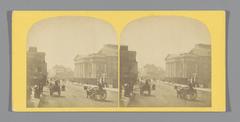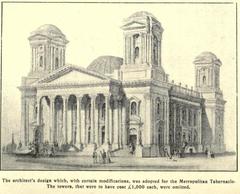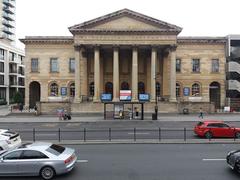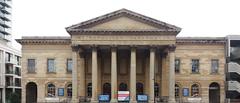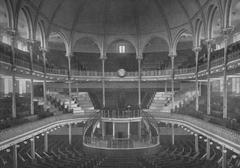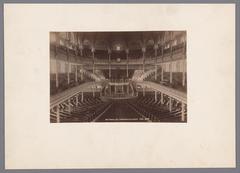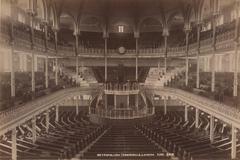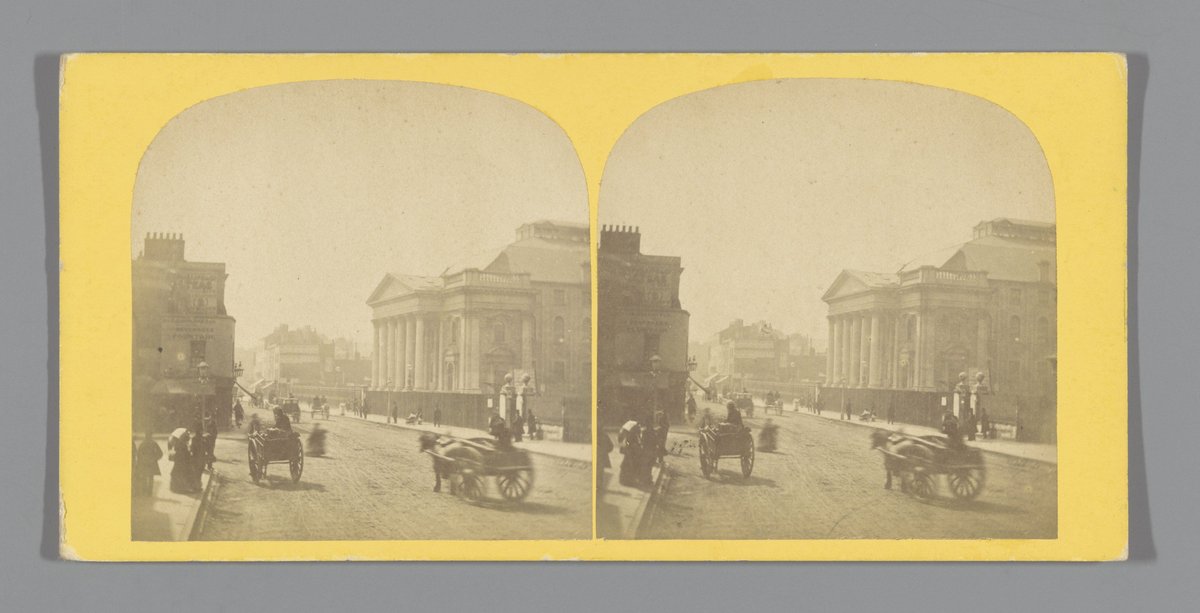
Metropolitan Tabernacle London: Visiting Hours, Tickets, and Historical Guide
Date: 15/06/2025
Introduction
Situated at Elephant and Castle in South London, the Metropolitan Tabernacle stands as one of Britain’s foremost religious and historical landmarks. With roots stretching back to the 17th century, the Tabernacle is renowned for its resilience through persecution, fire, and war, as well as its vital role in global Baptist history. Beyond its Victorian portico and striking sanctuary, it boasts a legacy of influential leadership, most notably under Charles Haddon Spurgeon, and remains a vibrant center of worship, education, and community engagement.
This comprehensive guide provides all you need to know to plan your visit—covering the Tabernacle’s history, architectural highlights, visiting hours, ticketing and accessibility, nearby attractions, and practical visitor tips. Whether you are a history enthusiast, spiritual seeker, or a tourist exploring London’s rich heritage, the Metropolitan Tabernacle offers a unique and memorable experience (metropolitantabernacle.org; reformedwiki.org).
Historical Overview
17th-Century Beginnings and Early Growth
The Metropolitan Tabernacle traces its origins to 1650, during a time of religious suppression in England. Baptists, including the church’s first pastor William Rider, met clandestinely at a house in Kennington, despite the threat of persecution. The arrival of Benjamin Keach in 1668 marked a turning point; Keach, compiler of the 1689 London Baptist Confession, led the congregation through hardship until the Act of Toleration in 1688 granted religious freedom. The first chapel was built at Horsleydown, Southwark (metropolitantabernacle.org; reformedwiki.org).
18th to Early 19th Century: Scholarship and Influence
Under Dr. John Gill (1720–1771), a renowned biblical commentator, the church became a hub of theological learning. Dr. John Rippon succeeded Gill and served for over six decades, guiding the congregation to become the largest Baptist church in Britain. The church actively supported the evangelical revival, including the preaching of George Whitefield (metropolitantabernacle.org; reformedwiki.org).
The Spurgeon Era: Expansion and Global Reach
Charles Haddon Spurgeon’s arrival in 1854 transformed the Tabernacle into the most influential nonconformist church of the Victorian era. His powerful preaching drew crowds so large that services moved from the New Park Street Chapel to the Surrey Music Hall and ultimately required the construction of a new building at Elephant and Castle in 1861, designed to seat 6,000 (reformedwiki.org). Spurgeon established the Pastors’ College, an orphanage, and a literature society, and his sermons continue to be widely read and referenced (metropolitantabernacle.org).
Architectural Trials and Resilience
The original 1861 building, designed by William Willmer Pocock, was a marvel of Victorian architecture. However, it was destroyed by fire in 1898 and again by bombing during the Blitz in 1941, with only the portico and basement surviving each disaster. The current building, completed in 1957, incorporates these surviving elements and stands as a testament to the congregation’s perseverance (metropolitantabernacle.org; reformedwiki.org).
Postwar Renewal and Modern Ministry
The Tabernacle experienced a period of decline after World War II but underwent significant revival from the 1970s under Dr. Peter Masters. Today, it serves a diverse congregation, offers theological education through the London Reformed Baptist Seminary, and remains committed to international outreach and digital ministry (reformedwiki.org; files.metropolitantabernacle.org).
Visiting the Metropolitan Tabernacle
Location and Getting There
- Address: 131 Elephant and Castle, London SE1 6SD, United Kingdom
- Nearest Tube: Elephant & Castle (Northern and Bakerloo lines)
- Bus Routes: 1, 35, 40, 133, 343
- Parking: Limited on-street parking; public transport is recommended (Transport for London)
A map and travel guidance are available on the official Tabernacle website.
Visiting Hours and Service Times
- Sunday Services: 11:00 AM and 6:30 PM
- Wednesday Bible Study/Prayer: 7:30 PM
- Weekday Visits and Group Tours: By appointment through the church office
The building is primarily open during service times. Educational and group tours outside these hours can be arranged in advance. For up-to-date schedules and special events, always consult the official website.
Admission and Tickets
- Admission: Free for services and casual visits
- Tickets: Generally not required. Tickets may be necessary for special events, such as conferences or concerts—check the events calendar for details (Metropolitan Tabernacle Events).
Guided Tours
Guided tours are not routinely available but can be arranged for groups with ecclesiastical or academic interest. Special tours and extended opening hours are offered during major events, such as the annual Thanksgiving Conference.
Architectural and Interior Highlights
- Portico: The grand classical portico with six Corinthian columns, a surviving element from the 1861 structure, is an iconic photo spot (British Listed Buildings).
- Sanctuary: Spacious and acoustically designed, seats up to 1,200, with a central pulpit reflecting Reformed tradition.
- Interior Displays: Historical plaques, portraits, and exhibits in the vestibule commemorate Spurgeon’s ministry and the Tabernacle’s legacy.
- Bookshop: Located near the main entrance, it offers a rich selection of Christian literature, including Spurgeon’s works.
Accessibility
- Wheelchair Access: Ramps at the main entrance, accessible restrooms on the ground floor.
- Hearing Support: Hearing loops in the sanctuary.
- Language and Special Needs: Simultaneous translation and sign language interpretation during some services; ushers are on hand to assist (Metropolitan Tabernacle Church Details).
Worship Experience
Visitors are welcome at all services, which are marked by reverent worship, congregational hymn singing, and expository preaching. Services are conducted in English, with translations available. There is no formal dress code; smart-casual attire is typical.
- Sunday School: For children aged 3–16, concurrent with the morning service.
- Crèche: Staffed by volunteers for parents with infants.
Etiquette and Visitor Guidelines
- During Services: Maintain a respectful silence and turn off mobile devices.
- Photography: Not permitted during services, but may be allowed in vestibules or exterior areas with permission.
- Food and Drink: No café on site; nearby Elephant & Castle offers various dining options (Elephant & Castle Guide).
Special Events and Community Activities
- Annual Thanksgiving Conference: Lectures, seminars, and tours available in July.
- Concerts and Lectures: Hosted throughout the year—see the events calendar.
- Theological Education: The London Reformed Baptist Seminary offers part-time and online courses (files.metropolitantabernacle.org).
Nearby Attractions and Suggested Itineraries
- Imperial War Museum: Ten minutes’ walk.
- Borough Market: Renowned food market a short distance away.
- South Bank: Theatres, galleries, and riverside walks within 15 minutes.
- Mercato Metropolitano: Vibrant food market nearby.
Combine a morning service with lunch and an afternoon exploring local culture (Visit London).
Frequently Asked Questions (FAQ)
Q: What are the visiting hours?
A: Sundays 11:00 AM and 6:30 PM, Wednesdays 7:30 PM; group visits by appointment.
Q: Is there an admission fee or are tickets required?
A: Admission is free. Tickets may be needed for special events.
Q: Are guided tours available?
A: Available for groups by prior appointment; check for special events.
Q: Is the site accessible for wheelchairs and hearing-impaired visitors?
A: Yes; ramps, accessible restrooms, and hearing loops are provided.
Q: Can I take photographs?
A: Not during services; allowed in public areas with permission.
Q: Are children welcome?
A: Yes; Sunday School and crèche facilities are available.
Summary and Recommendations
The Metropolitan Tabernacle remains a beacon of faith, history, and community in London. Its journey from secret meetings in the 17th century, through Spurgeon’s era of global influence, to its endurance through fire and war, reflects a remarkable legacy. Today, visitors are drawn by its architectural grandeur, historical displays, and vibrant worship life. With free admission, accessible facilities, and proximity to other landmarks, it is a must-visit for anyone exploring London’s spiritual and cultural heritage.
Before visiting, consult the official Metropolitan Tabernacle website for the latest information on hours, events, and group tours. Embrace the opportunity to experience this living legacy firsthand.
Sources and Further Reading
- Metropolitan Tabernacle Official Website
- Metropolitan Tabernacle, Reformed Wiki
- London Reformed Baptist Seminary Faculty and History
- Metropolitan Tabernacle Visitor Guide
- Elephant & Castle History: Metropolitan Tabernacle
- British Listed Buildings
- Spurgeon’s Legacy
- Visit London
- Transport for London
- Elephant & Castle Guide
